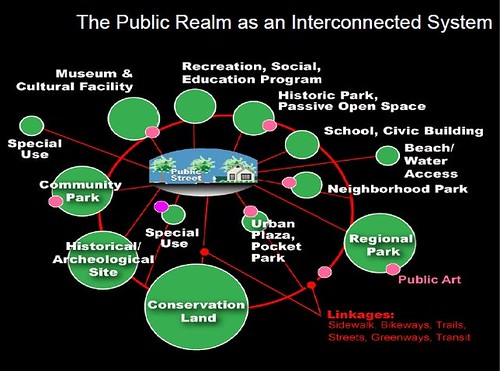Sometimes parks are bad ideas: Silver Spring, Maryland edition
Left: image by Jared Angle of the Silver Spring Transit Center. From the WAMU-Radio story "Leggett Remains 'Optimistic' About Silver Spring Transit Center."
According to "In Silver Spring, interest grows in creating park adjacent to troubled transit center" in the Washington Post, there is talk about making a park out of a 2 acre parcel next to the Silver Spring Transit Center-Metro Station, sort of as "reparations" for the debacle that the Transit Center has become ("No pay for fixing shoddy work on Silver Spring Transit Center" and "Cracks in Silver Spring Transit Center fracture profitable political and corporate marriage," Post). There had been a development project slated for the site, but it has fallen through.
Silver Spring has many public spaces (some privately owned but managed to be publicly accessible) but most hardscaped, not "green." From the article:
The result has been a city peppered with small pieces of concrete open space, most open to the public but in private hands. A 2010 Montgomery study counted 57 public-use spaces in central Silver Spring, covering 32.6 acres. Forty-seven are hardscape.One of the problems with "parks" is that everybody says they want them, but more important than the space itself is a plan and program for using the space.
I wrote an awesome post ("The layering effect: how the building blocks of an integrated public realm set the stage for community building and Silver Spring, Maryland as an example") about Silver Spring 18 months ago that did not generate even one comment awhile back that discusses this broad issue.
It makes the point that linking programming to space is key and that Silver Spring has lots of little spaces that exist but are unmanaged.
Similarly, some sites are better than others at achieving certain objectives. Not every site has to achieve every possible public objective and desire.
Green spaces and open spaces next to urban subway stations aren't necessarily the best way to leverage the hundreds of millions of dollars invested in the transit complex at Silver Spring (the transit center, the Metrorail station, the MARC station, etc.) or in the transit system more generally.
That being said, the role of stations as entry points into communities should be better managed. See "Transit, stations, and placemaking: stations as entrypoints into neighborhoods."
However, while exceedingly important, the area of the Silver Spring Metrorail station is not the "town center" of Silver Spring in the same way that Metrorail stations are re-centering neighborhoods like Brookland.
The Farmers Market on Ellsworth Avenue, Silver Spring. Photo from the AnnieRie Unplugged blog.
From a public space standpoint, the center of Silver Spring is the Veterans Plaza and building, and Ellsworth Avenue and the small public plaza fronting it, and the frequent closing of the street for special events, which will be complemented by a new library being constructed one block away, at the corner of Wayne Avenue and Fenton Street.
Silver Spring Veterans Plaza from above. Image from the Thayer Avenue blog post, "The Box is Open."
The focus in Silver Spring should be on improving the current public spaces and organizing them into a functioning network of public spaces, not on creating more spaces, unless there is a particularly compelling reason to do so.
Creating a space at the Metro station may well produce another under-utilized space. More importantly, it make sense to focus intensity on and improving the existing spaces, and at the site in question, to build something other than a park to take advantage of the value of Metrorail proximity.
Concept of the integrated public realm framework (slide, below) by David Barth.

According to the Post article, the piece of land is owned by WMATA. From the article:
The land is owned by Metro, which will eventually operate the bus and train hub. The center is about three years behind schedule and tens of millions of dollars over budget because of design and construction issues. County officials plan to resume repair work in the spring, and no opening date has been set.The thing is, the debacle isn't WMATA's fault, it's Montgomery County's fault.
“This might be something that, if it’s done right, is a little payback for the debacle,” Riemer said.
And WMATA can't just give the land to MoCo without trying to realize revenue from it. That's an issue at other Metro sites too (e.g., Takoma, Brookland), where some residents fight development by suggesting the sites be used for parks.
Because the WMATA system is funded regionally, no one jurisdiction can disproportionately benefit from land sale decisions. Given the discussions in Takoma, where WMATA makes it very clear they have no interest in holding park land, the land would have to be sold. And it's worth millions of dollars.
For MoCo to use this space as a park, they have to pay for it.
Labels: parks planning, public realm framework, transit oriented development, urban design/placemaking






2 Comments:
This transit center represents the bad karma of canceling the B&O North Central Freeway which should go right through this center's site.
Thank you again for your flawless service, and I look forward to working with you in the future.
Post a Comment
<< Home